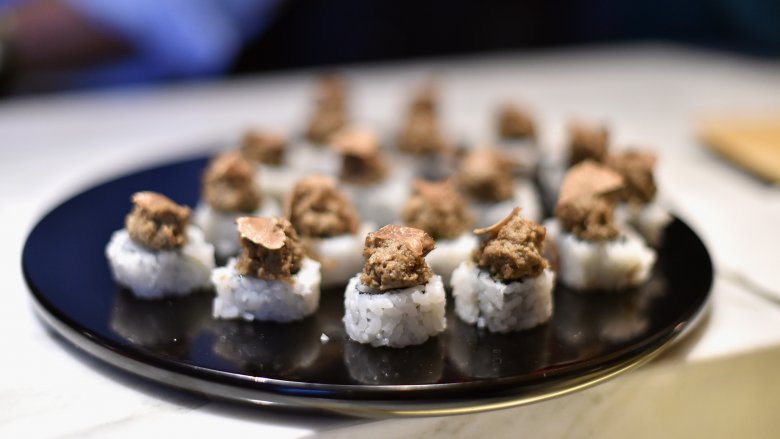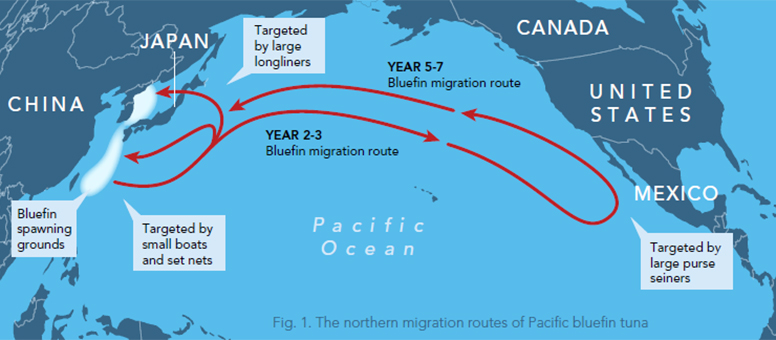There are generally three bluefin species: the Pacific bluefin and the Atlantic bluefin in the Northern Hemisphere and the southern bluefin in the Southern Hemisphere. Bluefin is found all over the Atlantic, Pacific, and Indian Oceans and is pound for pound one of the most expensive fish in the world. Even though the Pacific and Atlantic Tuna can live to 20-40 years old and can grow to between 0ne to two thousand pounds. Why does Tuna demand such high prices?
Limited supply
Exporting costs-flying worldwide
Exporting tuna caught in USA to Japan for butchering & processing
Overfishing of the bluefin population
Bluefin don’t breed in captivity
Demand for Bluefin in the 1970s when sushi became popular
Habitat of bluefin affects the cost
Auctioning method in Japan
The Bluefin Tuna is one of the largest fish in the world. The US accounts for about 5% of the global bluefin tuna catch, and over half of the US catch is exported, mainly to Japan. About 3/4 of the global bluefin catch goes to Japan where its fatty flesh is consumed as the highest grades of sushi and sashimi are maguro and toro.
Why is Bluefin Tuna So Expensive
Why this type of Tuna is so expensive is because of the popularity of Sushi all around the world. Bluefin Tuna has been sold for up to 3.1 million dollars by a Japanese buyer who is known as a self- styled Tuna King named Kiyoshi Kimura.
styled Tuna King named Kiyoshi Kimura.
But that is not the only reason why this bluefin tuna has been auctioned for this high amount. Before a piece of tune ends up in your stomach it has traveled from Japan all the way to your country. The bluefin tuna is extremely rare and is known for its very high-quality meat.
Catching a bluefin tuna is also a specialty that takes a lot of effort. Anyways, traditionally the first tuna of the year that has been auctioned sets the tone for the rest of the season. So that’s the reason this tuna is so expensive.
You can call this a good marketing and publicity stunt of the “King” Kiyoshi Kimura. The rest of the Tuna caught in the Tuna season is auctioned, based on what Kimura starts the bidding at. The popularity of Bluefin Tuna has exploded over the years more in Japan than in any other country.
There are three main species of bluefin tuna in the world: the Atlantic, the Southern, and the Pacific. The first two are officially listed as endangered species. The Pacific bluefin, by contrast, has received far less attention in part because it wasn’t even recognized as a distinct species until 1999.
The five kinds of Tuna are northern bluefin, southern bluefin, bigeye, yellowfin, and albacore. The prices can not only vary depending on the kind but also on other factors, such as whether it was caught in the wild or bred on a fish farm, or if it has been frozen. Bluefin is the most popular worldwide.
Bluefin Tuna Sushi Price
 Most restaurants anywhere in the world that serve Sushi use Bluefin Tuna as an overall favorite for most people who love the experience of eating raw fish. The most common and popular cut of Tuna is the meaty red Akami or the more fatty cut of Tuna called Chutoro or Otoro which is even fattier that will fall apart in your mouth.
Most restaurants anywhere in the world that serve Sushi use Bluefin Tuna as an overall favorite for most people who love the experience of eating raw fish. The most common and popular cut of Tuna is the meaty red Akami or the more fatty cut of Tuna called Chutoro or Otoro which is even fattier that will fall apart in your mouth.
Kimura the Tuna King that owns and operates dozens of Sushi Restaurants made the news when he paid 3.1 million on a 278 kg Bluefin Tuna. That is around 5000 dollars per pound. In Japan, there is a real premium placed on the finest Tuna. There are other fine foods that are quite expensive in Japan, Tuna just being one of them.
Most if not all of Japan’s best Tuna comes from one area of Japan. Called Shimokita Penninsula, Aomori in the northern town of Oma’s waters is where fishermen hunt to find Bluefin Tuna. After they are caught they are auctioned out in Tokyo.
This area has a coastline that looks like it could be from another planet. The rock formations are called Hotekegaura Rock Formations in Shimokita. This area attracts many visitors and is considered one of Japan’s contributions to the Wonders of the World.
This straight between the Sea of Japan and the Pacific ocean holds special currents that provide the habitat for what call Oma’s Black Diamond Bluefin Tuna named because of the price they auction for. This is the most fertile ground for Tuna.
Bluefin tuna, also known as maguro in Japanese, is very large. It is a Japanese tradition that not a single part from head to tail is wasted. The taste, the price, and the name of the cut vary according to the body part it is from. Let’s introduce those cuts here.
Otoro is the name of the fattiest part of a tuna. Otoro has a characteristic sophisticated taste and a distinctive fat marbling which makes the pieces melt in your mouth. The area on the abdomen near the gills is called Harakami, and the center of the abdomen is called Haranaka.
Chutoro refers to parts of the tuna that can be found on both the back and stomach of the fish. More specifically, the part of the back close to the head is called Sekami, the center of the back is called Senaka, and the part closest to the tail is sashimi. The section close to the tail is called Harashimo.
Akami is the name for the center of the tuna’s body. This cut has the least fat out of the whole fish, which makes it the most affordable.
Bluefin Tuna is known as the most expensive fish in the ocean. Bluefin Tuna can be staggeringly expensive, depending on where it was caught, and where you buy it. It’s reported that the finest Bluefin Tuna comes from Japan, and can be valued at around $200 per pound. Bluefin Tuna that is seasoned can cost $400 per/pound.

It’s been the target of commercial fisherman since the 1950s and because of this researcher have seen a giant drop in the population of these giant fish which again, bring up the demand and then adds to the price.
The five kinds are northern bluefin, southern bluefin, bigeye, yellowfin, and albacore. The prices can not only vary depending on the kind but also on other factors, such as whether it was caught in the wild or bred on a fish farm, or if it has been frozen.
Some 5-star restaurants fly their Tuna into the states from places in Japan like Masa, in New York City, which is the most expensive sushi restaurant in the entire country, according to Food & Wine. Dinner at Masa runs nearly $600 per person, without beverages or tax, and while Masa does not accept tips or any other gratuities, that’s still a seriously large sum to spend. They are considered one of the best resteraunts in the city
Sushi expert and chef Derek Wilcox told Business Insider that “Japan is simply better at handling the butchering of bluefin. It’s not uncommon for bluefin caught off the United States coast to be sent to Japan before being exported to a sushi restaurant someplace else. This drives up the cost”
How Long Do Bluefin Tuna Live
The Bluefin Tuna is characterized by a metallic gray, blue, and silver body with retractable fins and eyes set flush against the body. These are gigantic fish, often weighing between 1,000 and 2,000 pounds in size. The largest bluefin ever caught set a world record of 1,500 pounds. This fish can live up to 40 years old and is characterized by a metallic gray, blue, and silver body with retractable fins and eyes set flush against the body. The bluefin is one of the top predators in the open oceans. Its fast speed and large size make it a formidable presence.
The bluefin reproduces every spawning season by releasing millions of sperm and eggs into the water column. These fertilized eggs hatch after only a few days, but most of them are lost from attrition almost immediately. A Bluefin Tuna can travel at speeds of up to 50 miles per hour. Still with everything going for it
According to NOAA:
- Pacific bluefin tunas reach maturity at approximately 5 years of age and can live up to 26 years, although the average lifespan is about 15 years.
- Adults are approximately 1.5 meters (4 feet 11 inches) long and weigh about 60 kilograms (130 pounds).
- The maximum reported length and weight for Pacific bluefin tuna is 3 meters (9.8 feet) in length and 450 kilograms (990 pounds).
- Pacific bluefin tunas are predatory and mainly eat squids and fish, such as sardines and anchovies, saury, herring, pompanos, mackerel, hake, other tunas, and occasionally red crabs and krill.
- Atlantic Bluefin tuna grow more slowly than other tuna.
- They have a long lifespan, up to 20 years or more, and generally don’t spawn until they are about 8 years old.
- They spawn from mid-April to June, mainly in the Gulf of Mexico.
- Females can produce up to 10 million eggs a year.
- Juveniles eat fish, squid, and crustaceans, and adults feed mainly on baitfish such as herring, bluefish, and mackerel.

All three species of bluefin tuna are overfished and the fish don’t breed in captivity. Japan which is the largest consumer of Bluefin Tuna has faced international criticism for its harsh fishing of bluefin. It wasn’t always this way, either. The popularity of Sushi has grown making Bluefin the most targeted fish in the ocean. A local Bluefin caught on the East Coast of America will cost $20-40- dollars a pound but a Bluefin Tuna shipped from the coast of Japan would cost up to $200 a pound at market price. If the Tuna is seasoned for lengths of time that prime piece could fetch $400 dollars per pound or more.
The cost of Bluefin Tuna mostly depends on the location shown in the Bluefin Tuna Population Graph of where the Bluefin was taken from its prime habitat of ocean water and processed fresh for Japan and the rest of the world to enjoy!
JimGalloway Author/Editor
References: Toro, Chutoro, and Maguro: Tuna and Its Many Names
NOAA-Pacific Bluefin Tuna
Mashed-Why Is Bluefin Tuna So Expensive?


